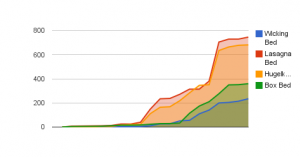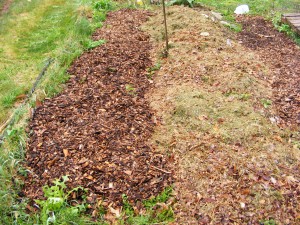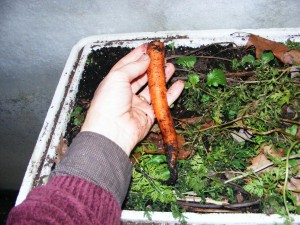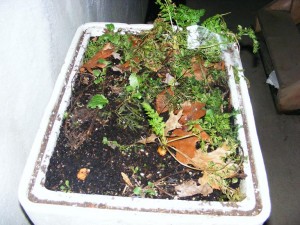
scale in ounces
Now that we’re in February and the catalogs are coming in at least once every couple of weeks, I am getting back to this site, and planning the new garden. First, though, a review of last year’s garden layout and what worked in a wet and weird season: As you can see, the lasagna bed and the hugelkultur bed were pretty close! The advantage of the hugelkultur bed is that it is not supposed to need any additional materials this year, and should start offering up the nutrients from the buried logs from last year for the next three to five years. Good thing, as this was quite labor intensive! The lasagna bed will need an additional 1″ of composted manure, and a covering of compost. The wicking bed sprang a leak and will have to be redone this year, and the box bed will need new boxes or be converted to lasagna beds to be viable again.
Also last year’s wicking beds were relying on fallow soil from a previous garden, and the box beds were several experiments rolled into one: some with minimal soil, some with lasagna layers, and the potatoes with fallow soil/grass clippings mix.
Box Beds:
- Best Crop per plant in 2011: bush beans, though patty pans did well too – they were in a box with added compost as opposed to fallow soil
- + easy to set up
- + customize-able for each type of crop, including “mini-wicking beds”
- + easily weeded
- – lower yield in most cases (due to mix of experiments including minimal soil/fallow soil)
- – without dressing up the borders, they looked ugly
Wicking Beds:
- Best Crop per plant in 2011: Cucumbers
- + low watering requirements
- – susceptible to leaks (dependent upon the substrate used)
- – lower than expected yield – most likely due to using fallow soil
Lasagna Bed:
- Best Crop per plant in 2011:Snow Peas
- + highest yield
- + low maintenance
- – compared to the hugelkultur bed, would have to be “refreshed” annually
Hugelkultur Bed:
- Best Crop per plant in 2011: Tomatoes
- + good yield for most crops, especially the heavy feeding squash
- + low maintenance after initial setup
- – labor intensive initially
- – root crops did not work well in the first year
This year the experiments should include:
Box Beds Year 2 – good soil mix, strawberry pyramid, box on box, and mini wicking box beds with bush beans (were tomato plants last year)
Hugelkuture Bed Year 2 – 1/2″ of composted manure and a killing mulch, crops rotated, nothing more
Lasagna Bed Year 2 – 1″ manure, 1″ compost and a killing mulch
Wicking Bed Year 2 – REDO – dig up, lay down plastic again, fill with good mix of soil/manure/compost
Beyond that, we have
- the strawberry plants that were transplanted last year next to the comfrey
- Asparagus plants that have to be moved into a new bed
- possibly some other experiments, depending on how adventurous I am and how much time I have.
ary and the catalogs are coming in at least once every couple of weeks, I am getting back to this site, and planning the new garden. First, though, a review of last year’s garden layout and what worked in a wet and weird season:

scale in ounces
As you can see, the lasagna bed and the hugelkultur bed were pretty close! The advantage of the hugelkultur bed is that it is not supposed to need any additional materials this year, and should start offering up the nutrients from the buried logs from last year for the next three to five years. Good thing, as this was quite labor intensive! The lasagna bed will need an additional 1″ of composted manure, and a covering of compost. The wicking bed sprang a leak and will have to be redone this year, and the box bed will need new boxes or be converted to lasagna beds to be viable again.
Also last year’s wicking beds were relying on fallow soil from a previous garden, and the box beds were several experiments rolled into one: some with minimal soil, some with lasagna layers, and the potatoes with fallow soil/grass clippings mix.
Box Beds:
- Best Crop per plant in 2011: bush beans, though patty pans did well too – they were in a box with added compost as opposed to fallow soil
- + easy to set up
- + customize-able for each type of crop, including “mini-wicking beds”
- + easily weeded
- – lower yield in most cases (due to mix of experiments including minimal soil/fallow soil)
- – without dressing up the borders, they looked ugly
Wicking Beds:
- Best Crop per plant in 2011: Cucumbers
- + low watering requirements
- – susceptible to leaks (dependent upon the substrate used)
- – lower than expected yield – most likely due to using fallow soil
Lasagna Bed:
- Best Crop per plant in 2011:Snow Peas
- + highest yield
- + low maintenance
- – compared to the hugelkultur bed, would have to be “refreshed” annually
Hugelkultur Bed:
- Best Crop per plant in 2011: Tomatoes
- + good yield for most crops, especially the heavy feeding squash
- + low maintenance after initial setup
- – labor intensive initially
- – root crops did not work well in the first year
This year the experiments should include:
Box Beds Year 2 – good soil mix, strawberry pyramid, box on box, and mini wicking box beds with bush beans (were tomato plants last year)
Hugelkuture Bed Year 2 – 1/2″ of composted manure and a killing mulch, crops rotated, nothing more
Lasagna Bed Year 2 – 1″ manure, 1″ compost and a killing mulch
Wicking Bed Year 2 – REDO – dig up, lay down plastic again, fill with good mix of soil/manure/compost
Beyond that, we have
- the strawberry plants that were transplanted last year next to the comfrey
- Asparagus plants that have to be moved into a new bed
- possibly some other experiments, depending on how adventurous I am and how much time I have.
Related Blogs
Related Blogs
Related Blogs
style”. As our neighbors have a lot of horses and the waste that has been piled over the winter is about to be spread out over their fields, I’ll be making a “stink run” shortly. Here’s a great resource for working with your garden (and your neighbors): “A Horse Owner’s Guide to Good Stewardship“.
















Recent Comments